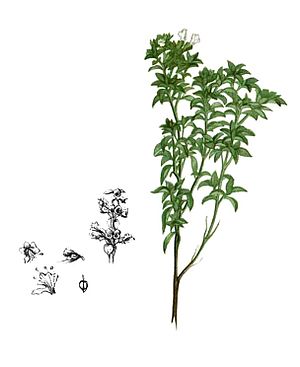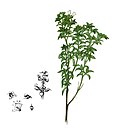Note: This is a project under development. The articles on this wiki are just being initiated and broadly incomplete. You can Help creating new pages.
Ocimum canum
Ocimum Canum belongs to the Lamiaceae family. This annual plant is native to the African continent and grows to a height of 2 feet. It is also known as the African basil with a distinct mint flavor, with hairy leaves and scented flowers.
Contents
[hide]- 1 Uses
- 2 Parts Used
- 3 Chemical Composition
- 4 Common names
- 5 Properties
- 6 Habit
- 7 Identification
- 8 List of Ayurvedic medicine in which the herb is used
- 9 Where to get the saplings
- 10 Mode of Propagation
- 11 How to plant/cultivate
- 12 Commonly seen growing in areas
- 13 Photo Gallery
- 14 References
- 15 External Links
Uses
Colds, Fevers, Parasitic infestations, Headaches, Inflammation of joints, Dysentary, Tooth problems.[1]
Parts Used
Chemical Composition
It contains following Chemical constituents Thymol (42.15%), p-cymene (21.17%) and γ-terpinene (19.81%) as major compounds[2]
Common names
| Language | Common name |
|---|---|
| Kannada | Nayi tulasi |
| Hindi | Kala Tulasi |
| Malayalam | Katturamatulasi |
| Tamil | Nay Tolasi |
| Telugu | Kukka Tulasi |
| Marathi | |
| Gujarathi | |
| Punjabi | |
| Kashmiri | |
| Sanskrit | Ajaka |
| English | Wild basil |
Properties
Reference: Dravya - Substance, Rasa - Taste, Guna - Qualities, Veerya - Potency, Vipaka - Post-digesion effect, Karma - Pharmacological activity, Prabhava - Therepeutics.
Dravya
Rasa
Guna
Veerya
Vipaka
Karma
Prabhava
Habit
[[:Category:Habit - |]]
Identification
Leaf
| Kind | Shape | Feature |
|---|---|---|
| Elliptic | Pointed to tapering | Base flat or blunt, Nearly entire |
Flower
| Type | Size | Color and composition | Stamen | More information |
|---|---|---|---|---|
| Borne in racemes | 5mm long | White | Densely velvet hairy, Filaments hairless. Flowering season is August |
Fruit
| Type | Size | Mass | Appearance | Seeds | More information |
|---|---|---|---|---|---|
| Nutlets | 1.5mm long | Sub trigonous | Minutely fitted | Dark brown | Fruiting season is August |
Other features
List of Ayurvedic medicine in which the herb is used
Where to get the saplings
Mode of Propagation
[[:Category:Index of Plants which can be propagated by |]]
How to plant/cultivate
It flourishes in conditions of lot of sun, well drained soils and access to heat.[5]
Commonly seen growing in areas
[[:Category:Herbs that are commonly seen in the region of |]], [[:Category:Herbs that are commonly seen in the region of |]], [[:Category:Herbs that are commonly seen in the region of |]], [[:Category:Herbs that are commonly seen in the region of |]], [[:Category:Herbs that are commonly seen in the region of |]].
Photo Gallery
References
- Jump up ↑ Indian Medicinal Plants by C.P.Khare
- Jump up ↑ Industrial Crops and Products Volume 119, Pages 201-208
- Jump up ↑ "Karnataka Medicinal Plants Volume - 2" by Dr.M. R. Gurudeva, Page No.756, Published by Divyachandra Prakashana, #45, Paapannana Tota, 1st Main road, Basaveshwara Nagara, Bengaluru.
- Jump up ↑ Kappatagudda - A Repertoire of Medicianal Plants of Gadag by Yashpal Kshirasagar and Sonal Vrishni, Page No. 283
- Jump up ↑ [Cultivation]
External Links
- Ayurvedic Herbs known to be helpful to treat Colds
- Ayurvedic Herbs known to be helpful to treat Fevers
- Ayurvedic Herbs known to be helpful to treat Parasitic infestations
- Ayurvedic Herbs known to be helpful to treat Headaches
- Ayurvedic Herbs known to be helpful to treat Inflammation of joints
- Ayurvedic Herbs known to be helpful to treat Dysentary
- Ayurvedic Herbs known to be helpful to treat Tooth problems
- Herbs with Whole herb used in medicine
- Herbs with common name in Kannada
- Herbs with common name in Hindi
- Herbs with common name in Malayalam
- Herbs with common name in Tamil
- Herbs with common name in Telugu
- Herbs with common name in Sanskrit
- Herbs with common name in English
- Habit -
- Index of Plants which can be propagated by
- Herbs that are commonly seen in the region of
- Herbs
- Pages without herbs images

